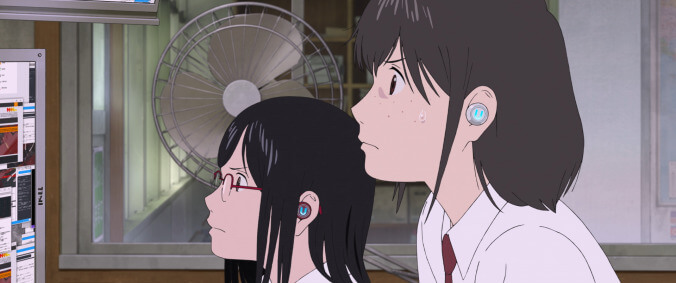Photo: © 2021 STUDIO CHIZU
Put in the simplest terms, Mamoru Hosoda’s animated film Belle is an ultra-modern cautionary tale about social media and virtual reality, in which a shy schoolgirl named Suzu becomes a popular—and controversial—singing star within an immersive online community called “U.” But that description barely begins to cover everything that happens in a movie that encompasses naturalistic teen melodrama, tech-savvy mystery, clear-eyed commentary on the internet’s potentials and pitfalls, and—no joke—a remake of Disney’s Beauty And The Beast. All of this is rendered in an impressive array of visual styles, from cartoonish and fantastical to docu-realistic.
In the original Japanese-language version of Belle (an English-language dub is also in circulation) Kaho Nakamura voices Suzu, who lives in a small town where everyone knows everyone else’s business. Suzu has a reputation as “the sad girl,” sullen and withdrawn ever since her mother died—a tragedy that derailed Suzu’s love of music, a hobby she shared with her mom.
Hosoda tells the story of that death early in the film, in a sequence that also establishes one of Belle’s main motifs. Suzu’s mother was killed wading into a rushing river to save a drowning child. And while Suzu’s barely coping with her own feelings of loss, she’s also been saddled with the opinions of online scolds, who criticize her mom for abandoning her own kid to save another. Belle’s reality is much like our own: Anything that draws any notice at all affords an opportunity for internet randos to offer an opinion.
So it goes when Suzu’s nerdy best friend Hiro (Lilas Ikuta) encourages her to join “U,” a virtual reality hangout where people appear as customized, idealized avatars, reflecting either who they wish to be or who they secretly are. Suzu plays off the English meaning of her name and calls her own long-haired, fashion-forward avatar “Bell”—later re-dubbed “Belle” by her legions of fans. Soon, she finds that inside “U,” she can sing again. And with the canny Hiro’s help, her Belle becomes an international sensation. But Suzu also learns that fame comes with complications, including amateur sleuths who try to figure out her actual identity and haters who take pleasure in trashing Belle. (According to Hiro, this is a good thing: Universally beloved figures have only a niche audience, while “stardom is built on mixed reaction.”)
Hosoda and his company Studio Chizu (co-founded with his longtime producing partner Yuichiro Saito) previously made 2018’s Mirai, an Oscar-nominated film about a jealous, bratty older brother who gets an attitude correction after he takes some little trips through time to see his family’s past and future. Fans of Mirai will be used to Hosoda’s quirky storytelling style, which links together short vignettes—some fanciful, some true-to-life.
Newcomers to Hosoda’s work, meanwhile, may need to adjust a bit to Belle. The film packs a lot into its two-hour running time, frequently shifting its focus away from the grabbiest parts of its plot. The movie starts out fairly straightforward, contrasting Suzu’s drab, melancholy adolescence with the sometimes scary thrill of becoming a viral hit online. But then one of Belle’s performances is disrupted by anarchic presence known alternately as “the Dragon” and “the Beast”—a character who is hunted across “U” by a team of anthropomorphic animal superheroes. When Suzu and Hiro track “the Dragon” to his lair, Belle ends up dwelling within his spooky castle for a while, getting to know his kind heart and deep pain. (It is, as they say, a tale as old as time.)
Then Belle twists yet again, becoming more about Suzu’s effort to uncover “the Dragon’s” real-world identity before the internet mobs. Meanwhile, she comes out of her shell back home, reconnecting with old friends and acquaintances and even getting involved in their love lives. There may be more going on here than there needs to be, as Hosoda’s narrative winds far away from its original idea of a backwoods nobody who becomes a secret superstar.
Individual moments in Belle are frequently magical: Many of the real-world scenes are beautifully staged and illustrated, with characters moving quietly and slowly through outdoor spaces while sunlight dapples across the water and birds flit by. Hosoda emphasizes the wonders that can’t be replicated even in a high-tech VR world, like the subtler shades and moods of a face-to-face conversation in a park on a lovely spring day.
Hosoda is no reactionary, though. He sees how the internet can be a useful tool as well as a cudgel. In one of Belle’s more memorable sequences—illustrated to look like the digital app version of a strategy board game—he shows how Suzu cleverly reroutes the high school rumor mill, sending texts and DMs to key influencers in her class, setting the record straight about herself and thus “flipping” her peers like tokens in Reversi. And in an especially haunting moment within “U,” Suzu is able to cut through the community’s above-it-all cynicism and get a chorus of followers to sing her song—all against “U’s” dazzling backdrop, filled with color and flash.
Ultimately, Belle is a thoughtful exploration of the opportunities allowed by internet anonymity. In a virtual world, people can try out new personas and ideas—and yes, some of them will inevitably be toxic. But people can also connect with new folks, experience their remarkable creativity, and experiment with empathy online. Then they can see how far that all takes them, after they’ve put their phones in their pockets and stepped outside.

